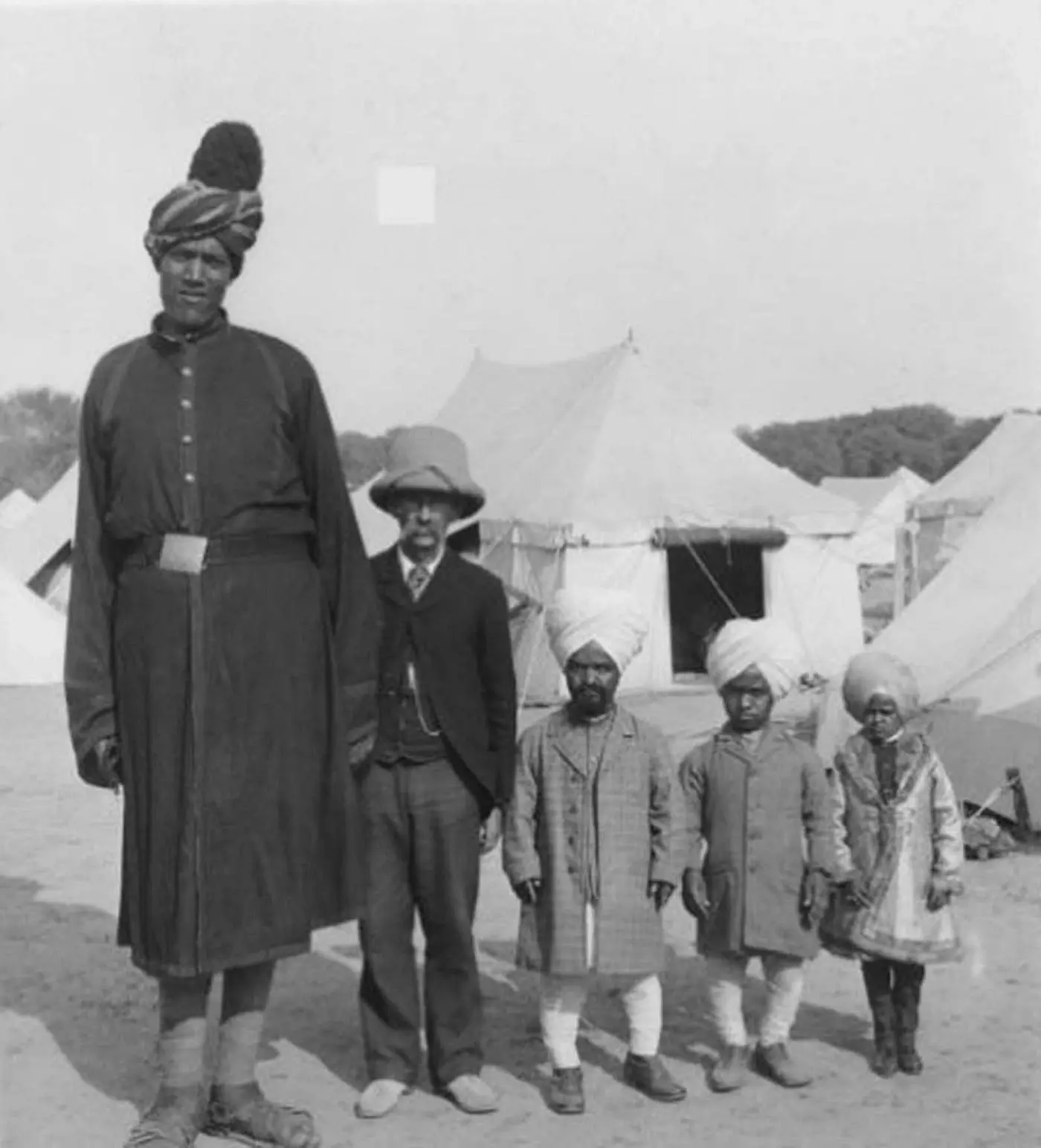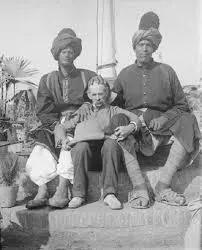Kashmiri Giants at Delhi Durbar: 1903’s Surprise
The 1903 Delhi Durbar was a grand event organised to celebrate the coronation of King Edward VII as Emperor of India. It was a display of British colonial power and Indian princely splendour, filled with vibrant ceremonies and majestic processions. However, amidst the elephants, jewels and royalty, it was two imposing Kashmiri figures who captured the attention of all present. These two men, at 2.36m and 2.23m tall, stood out not only for their height but also for the role they played as guards and riflemen to the King of Jammu and Kashmir.

Delhi Durbar parade in 1903.
The Delhi Durbar was an elaborate event, taking nearly two years to plan. It began with a magnificent elephant procession through the streets of Delhi on 29 December 1902. This was followed by the main coronation event on 1 January 1903, which took place on a vast plain just outside the city. Indian princes and kings, along with British dignitaries, gathered to witness the pomp and ceremony. The Durbar was intended to showcase the grandeur of the British Empire and its Indian territories, featuring a dazzling array of precious jewels.

Two giants of Kashmir.
Lord Curzon, the Viceroy of India at the time, planned the event meticulously. Despite the absence of King Edward VII, who refused to travel to India, Curzon made sure that the spectacle was second to none. The highlight of the event was the grand parade of Indian royalty on elephants, but what really captivated everyone were the two giant guards.
The 1903 Delhi Durbar was a grand event organised to celebrate the coronation of King Edward VII as Emperor of India. It was a display of British colonial power and Indian princely splendour, filled with vibrant ceremonies and majestic processions. However, amidst the elephants, jewels and royalty, it was two imposing Kashmiri figures who captured the attention of all present. These two men, at 2.36m and 2.23m tall, stood out not only for their height but also for the role they played as guards and riflemen to the King of Jammu and Kashmir.

Delhi Durbar parade in 1903.
The Delhi Durbar was an elaborate event, taking nearly two years to plan. It began with a magnificent elephant procession through the streets of Delhi on 29 December 1902. This was followed by the main coronation event on 1 January 1903, which took place on a vast plain just outside the city. Indian princes and kings, along with British dignitaries, gathered to witness the pomp and ceremony. The Durbar was intended to showcase the grandeur of the British Empire and its Indian territories, featuring a dazzling array of precious jewels.

Two giants of Kashmir.
Lord Curzon, the Viceroy of India at the time, planned the event meticulously. Despite the absence of King Edward VII, who refused to travel to India, Curzon made sure that the spectacle was second to none. The highlight of the event was the grand parade of Indian royalty on elephants, but the real stars of the show were the two giant Kashmiri guards.

Two giants of Kashmir and their exponent, Professor Ricalton.
The two Kashmiri giants, twin brothers, were a phenomenal sight. Standing at 2.40m and 2.23m tall, they were the tallest men of their time. Their presence at the Durbar drew immense attention from the crowd, dwarfing even the largest of the golden-candelabra-adorned elephants. These giants were not only a testament to their unique genetic stature but also to skilled marksmen dedicated to serving their king.
The brothers, who hail from a place known as Balmokand, brought with them an arsenal of weapons, demonstrating their willingness to protect their ruler. Their impressive height and formidable appearance made them the centre of attention and captivated journalists and photographers from around the world.

Two giants of Kashmir and their exponent, Professor Ricalton.
The appearance of the Kashmiri giants at the Durbar had a lasting impact. They were featured in numerous newspapers and articles, spreading their fame far beyond India. The Brisbane Courier highlighted their presence, describing them as part of the Kashmiri ruler’s entourage. American traveller and photographer James Ricalton was particularly taken with them, documenting their extraordinary stature in photographs that emphasised their imposing heights.
.webp)
Two giants of Kashmir.
Ricalton travelled to Kashmir with photographer George Rose to capture more images of these giants. One striking photograph showed the tallest giant next to the shortest dwarf, with Ricalton himself included for scale. This image vividly illustrates the incredible height difference, further cementing the giants’ place in history.
The Kashmiri Giants of the 1903 Delhi Durbar were more than just tall men; they were a symbol of the extraordinary and a highlight of an event designed to impress. Their presence added a unique and unforgettable element to the Durbar, commanding the attention of all attendees and leaving a lasting impression on history. Their story is a fascinating chapter in the annals of the British Empire and Indian royalty, showcasing the intersection of human diversity and historical spectacle.
s of Kashmir.

Two giants of Kashmir and their exponent, Professor Ricalton.
The two Kashmiri giants, twin brothers, were a phenomenal sight. Standing at 2.40m and 2.23m tall, they were the tallest men of their time. Their presence at the Durbar drew immense attention from the crowd, dwarfing even the largest of the golden-candelabra-adorned elephants. These giants were not only a testament to their unique genetic stature but also to skilled marksmen dedicated to serving their king.
The brothers, who hail from a place known as Balmokand, brought with them an arsenal of weapons, demonstrating their willingness to protect their ruler. Their impressive height and formidable appearance made them the centre of attention and captivated journalists and photographers from around the world.

Two giants of Kashmir and their exponent, Professor Ricalton.
The appearance of the Kashmiri giants at the Durbar had a lasting impact. They were featured in numerous newspapers and articles, spreading their fame far beyond India. The Brisbane Courier highlighted their presence, describing them as part of the Kashmiri ruler’s entourage. American traveller and photographer James Ricalton was particularly taken with them, documenting their extraordinary stature in photographs that emphasised their imposing heights.
.webp)
Two giants of Kashmir.
Ricalton travelled to Kashmir with photographer George Rose to capture more images of these giants. One striking photograph showed the tallest giant next to the shortest dwarf, with Ricalton himself included for scale. This image vividly illustrates the incredible height difference, further cementing the giants’ place in history.
The Kashmiri Giants of the 1903 Delhi Durbar were more than just tall men; they were a symbol of the extraordinary and a highlight of an event designed to impress. Their presence added a unique and unforgettable element to the Durbar, commanding the attention of all attendees and leaving a lasting impression on history. Their story is a fascinating chapter in the annals of the British Empire and Indian royalty, showcasing the intersection of human diversity and historical spectacle.
The Kashmiri Giants of the 1903 Delhi Durbar left a lasting impression. Towering at 2.40m and 2.23m, the brothers served as royal guards and riflemen for the King of Jammu and Kashmir. Their immense height captivated onlookers, overshadowing even the grand elephants of the parade. Documented in striking photographs, these figures became symbols of human wonder and the extraordinary diversity showcased at one of history’s most elaborate events.






